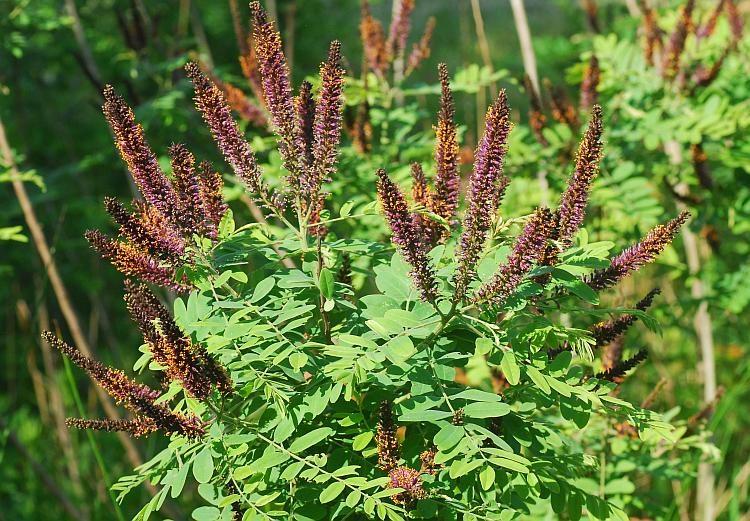Amorpha fruticosa L.
False Indigo

Native
CC = 6
CW = -3
MOC = 71
© SRTurner
Amorpha fruticosa L.False Indigo | |
 |
Native CC = 6 CW = -3 MOC = 71 |
© SRTurner |
|
Family - Fabaceae/Faboideae Habit - Shrub with thick roots and rhizomes. Stems - Ascending, woody, to 2 m, branched, multiple, glabrous, or young branches pubescent. Leaves - Alternate, odd-pinnately compound, with petiole to 3 cm. Leaflets typically oblong, to 40 mm long, entire, mucronate, opposite, glabrous above, pubescent underneath.
Inflorescence - Terminal and axillary racemes to 18 cm long. Pedicels 1-2 mm long.
Flowers - Calyces 5-lobed, the tube 2.0-2.4 mm long, the lobes 0.2-1.0 mm long, the lowermost lobe conspicuously longer than the other 4 lobes. Corollas not papilionaceous, the single petal 4-5 mm long, 2.5-3.0 mm wide, obovate, arched, folded around the stamens and pistil, dark bluish purple to dark purplish blue. Stamens 10, exserted, with the free portion of the filaments 3-4 mm long, the anthers yellowish orange to orange. Ovary superior, 1-2 mm long, usually glabrous, the style 4-5 mm long, exserted, glabrous or more commonly with ascending hairs.
Fruits - Modified legumes to 7 mm long, glabrous or sparsely pubescent, strongly exserted beyond persistent calyx, prominently pustular gland-dotted, 1-seeded. Seeds 3.5-4.0 mm long, 1.4-1.6 mm wide, tan to reddish brown.
Flowering - May - June. Habitat - Moist ground, gravel bars. Also cultivated. Origin - Native to U.S. Other info. - This striking shrub can be found throughout Missouri and is common throughout the Midwest. It is usually found in areas near water, such as margins of ponds and sloughs. When in flower, the plant is easily recognized by its distinctive inflorescences, which are like those of lead plant (A. canescens) but borne on a shrub with green (not canescent) foliage. The plant does well in gardens; however it is considered an invasive exotic in parts of New England and the Northwest, where it is not native. It can propagate clonally from vegetative fragments, such as roots and stems, deposited in flooding events. Numerous infraspecific forms have been described, but as these freely intergrade they are not formally recognized in Missouri. A hybrid between A. fruticosa and A. canescens has been reported, and is called Amorpha x notha Palmer. This entity is rare, since the parental species occupy very different habitats and are seldom found in proximity. Photographs taken in the Ozark National Scenic Riverways, Shannon County, MO., 5-19-03 (DETenaglia); also at Otter Slough Conservation Area, Stoddard County, MO, 7-18-2009 and 5-20-2014 (SRTurner). |